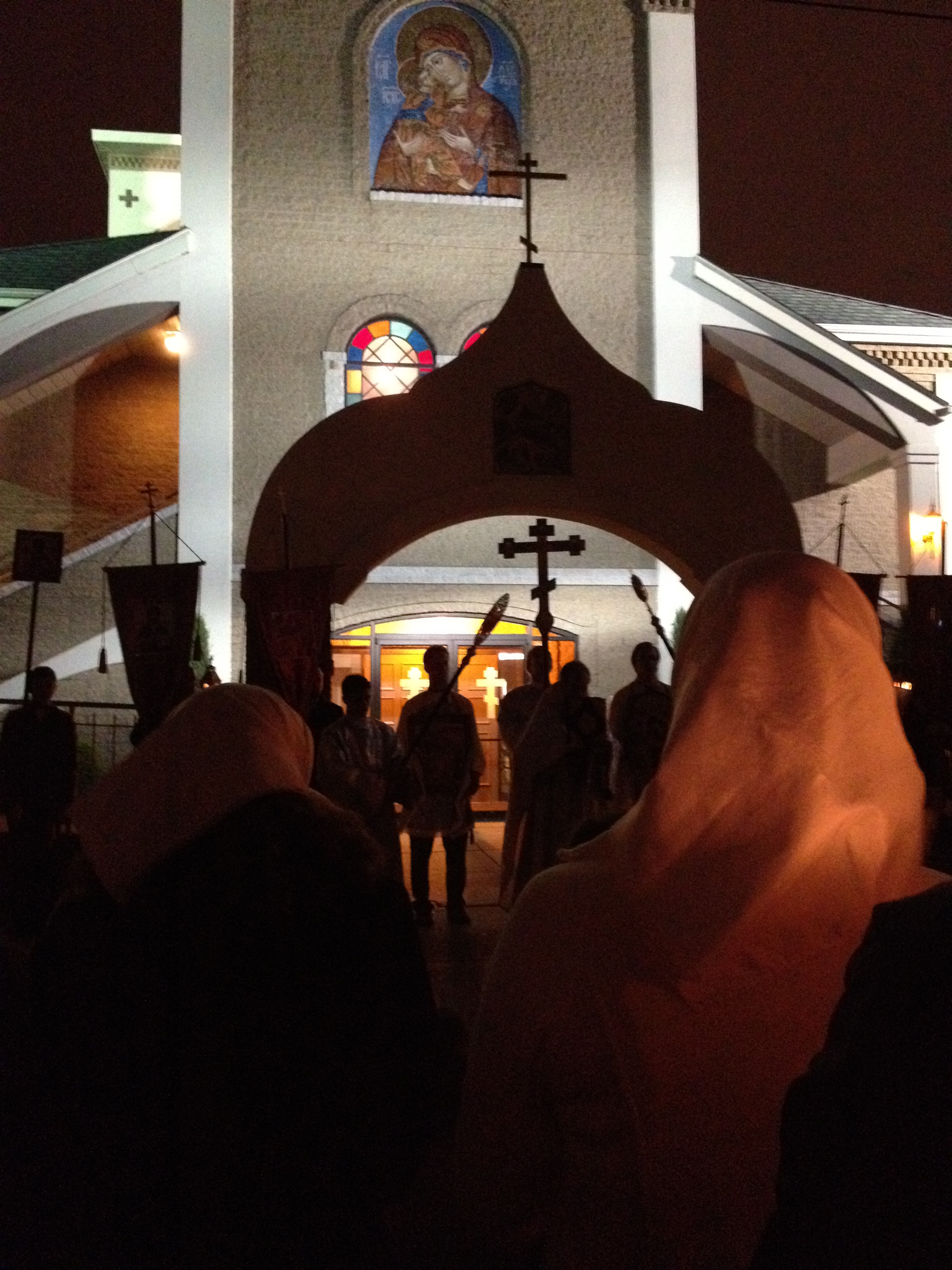Video of the Talk by Fr. Andrew Damick on Oct 10th 2012
Here are the links to youtube, where the video can be found. Due to the size of the video file and youtube restrictions it is in five (5) parts. Please click on full story for the actual links. Each video is approximately 10-12 minutes. Fr.Damick Part 1
Times-News coverage of Bishop Daniel's repose
Erie Times-News Article RE: Bishop Daniel's Repose In case any of you missed it, click the link above to view the article by Dana Massing in today's Erie Times-News regarding Bishop Daniel's repose.
Just a reminder that Bishop Jerome and Bishop George will both be attendance for services tomorrow morning. We hope to have a large number of parishioners in church as we lay our bishop to rest.
Grant Rest, O Lord, to the soul of Thy departed servant, the Bishop Daniel!
Grant rest, O Lord, to the soul of Thy departed servant, the Bishop Daniel!
Read MoreBishop Daniel reposes - UPDATED
Bishop Daniel reposed on Monday morning at approximately 8:45 a.m. Bishop Daniel will be brought to the church at 2:45 p.m. on Tuesday Afternoon. The Third Day Panahida will be served at 3 p.m. Vespers and Matins will be served as previously-scheduled, beginning at 4:30 p.m.
On Wednesday morning, Hours and Liturgy will be held on Wednesday morning at 7:15 a.m. Bishop George and Bishop Jerome plan to attend. A Hierarchal Liturgy will be served. Please consider attending this historic service. It would truly be an embarrassment if our church was empty during a Hierarchal Liturgy where two bishop came to lay our bishop to rest.
Immediately following the Liturgy (at approximately 9:30), the hierarchal funeral service will be held.
Check out the main article to read Bishop Daniel's obituary.
Parishioner News
No news to report yet! However, we'll soon start using this feature to make important parish news available for parishioners.
Explanation of the Three-Bar Cross
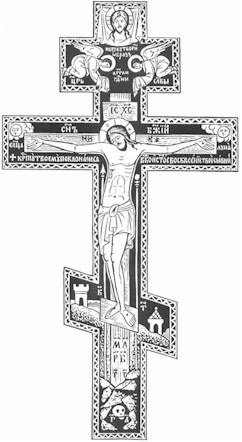 Through the Cross came our Salvation. We are constantly reminded that Christ died for us, and that He rose from the dead. The image of the crucified Lord reminds us of this.
On the Cross is our Savior, Jesus Christ. Note that He does not wear a crown of thorns, and that His feet are nailed with two nails. Behind the body of Christ, on either side, are a lance (which pierced Him) and a sponge (which was soaked with gall and offered to Christ to drink) on a pole made of reed or cane. On the body of Christ is depicted blood and water flowing forth from His side. Below the feet of Christ are four Slavonic letters meaning: "The place of the skull became Paradise". Hidden in a cave under the earth is 'the skull of Adam'. We are thus reminded that Adam our forefather lost Paradise through the tree from which he wrongly partook; Christ is the new Adam, bringing us Salvation and Paradise through the tree of the Cross. The city of Jerusalem is depicted in the background, for He was crucified outside the city walls.
Through the Cross came our Salvation. We are constantly reminded that Christ died for us, and that He rose from the dead. The image of the crucified Lord reminds us of this.
On the Cross is our Savior, Jesus Christ. Note that He does not wear a crown of thorns, and that His feet are nailed with two nails. Behind the body of Christ, on either side, are a lance (which pierced Him) and a sponge (which was soaked with gall and offered to Christ to drink) on a pole made of reed or cane. On the body of Christ is depicted blood and water flowing forth from His side. Below the feet of Christ are four Slavonic letters meaning: "The place of the skull became Paradise". Hidden in a cave under the earth is 'the skull of Adam'. We are thus reminded that Adam our forefather lost Paradise through the tree from which he wrongly partook; Christ is the new Adam, bringing us Salvation and Paradise through the tree of the Cross. The city of Jerusalem is depicted in the background, for He was crucified outside the city walls.
The Top Bar
The top bar is the title-board which Pilate 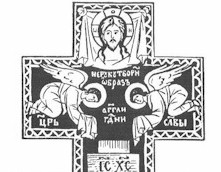 ordered to be hung in mockery over Christ’s head on the Cross. On this board was inscribed: "Jesus of Nazareth, King of the Jews" in Hebrew, Greek, and Latin (abbreviated to the Greek initials ‘INBI’ or the Latin initials ‘INRI’ in the Western tradition). This is replaced with the Christian inscription: "King of Glory" – below the knees of the angels. On the title-board is inscribed the initials 'IC XC', being the first and last letters of Christ’s name in Greek. In addition, just above Christ's arms we see the inscription: ‘NIKA’, which in Greek means: "He conquers" or "He is victorious." Frequently, we see these last two inscriptions together: 'IC XC NIKA', meaning: "Jesus Christ is victorious" (over death and sin).
ordered to be hung in mockery over Christ’s head on the Cross. On this board was inscribed: "Jesus of Nazareth, King of the Jews" in Hebrew, Greek, and Latin (abbreviated to the Greek initials ‘INBI’ or the Latin initials ‘INRI’ in the Western tradition). This is replaced with the Christian inscription: "King of Glory" – below the knees of the angels. On the title-board is inscribed the initials 'IC XC', being the first and last letters of Christ’s name in Greek. In addition, just above Christ's arms we see the inscription: ‘NIKA’, which in Greek means: "He conquers" or "He is victorious." Frequently, we see these last two inscriptions together: 'IC XC NIKA', meaning: "Jesus Christ is victorious" (over death and sin).
The Middle Bar
 The middle bar is that on which the Lord's hands were nailed. On either top corner we see the depiction of the sun (left) and the moon (right), for "The sun hid its light, and the moon turned to blood." (Joel 2:31) The inscription: "Son of God" is placed on both sides of Christ's head, and below His arms we read the inscription: "Before Thy Cross we bow down, O Master, and Thy holy Resurrection, we glorify". The halo of Christ is inscribed with three Greek letters meaning "The Being" or "He Who Is", to remind us that Christ is the same God Who identified Himself with those words to Moses in the Old Law.
The middle bar is that on which the Lord's hands were nailed. On either top corner we see the depiction of the sun (left) and the moon (right), for "The sun hid its light, and the moon turned to blood." (Joel 2:31) The inscription: "Son of God" is placed on both sides of Christ's head, and below His arms we read the inscription: "Before Thy Cross we bow down, O Master, and Thy holy Resurrection, we glorify". The halo of Christ is inscribed with three Greek letters meaning "The Being" or "He Who Is", to remind us that Christ is the same God Who identified Himself with those words to Moses in the Old Law.
The Bottom Bar
The slanted bottom bar is the foot-rest. There is some question of whether it was actually on the Cross of Christ, but it is acknowledged to be a necessary attribute of the Cross, worthy of veneration and prophetically alluded to in the words [Let us] worship the footstool of His feet... (Ps. 98:5).
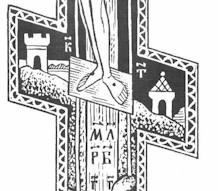 In prayers for the Ninth Hour, the Church likens the Cross to a type of balance of righteousness:
In prayers for the Ninth Hour, the Church likens the Cross to a type of balance of righteousness:
"Between two thieves Thy Cross did prove to be a balance of righteousness: wherefore one of them was dragged down to Hades by the weight of his blasphemy whereas the other was lightened of his transgressions unto the comprehension of theology. O Christ God, glory to Thee."
The meaning of this prayer is as follows: the Cross of Christ stood for a scale of justice between the two thieves: for one of them sank in to hell, dragged down by his blasphemous words; and the other, the wise thief, ascended into heaven, because of his repentance. The church fathers attempted to render tangible the thought of the unfaithful theif going to hell for his blasphemy throught the just judgement of God (the lower end of the bar), and of the wise thief going to heaven for his repentance and his praise of God (the upper end).
Volume IV, No. 3; May-June 1982 Living Orthodoxy was used as a source for some material on this page.
Our new website!
Thanks for visiting our newly-redesigned website. It has many features visitors have requested for years. We hope you enjoy it! Be sure to check out our new photo album as well as information on our upcoming Troika Festival.
The Orthodox Wedding Service
It is believed that in a Christian marriage the Holy Spirit is given so that what is begun on earth does not “part in death” but is fulfilled and continues most perfectly in the Kingdom of Heaven. The Sacrement of Marriage in the Orthodox Faith has some very ancient practices which will take place during the ceremony.
Read MoreOld Orthodox Prayer Book
This second edition of the Old Orthodox Prayer Book is a handsomely bound and printed, two-color, bi-lingual (Slavonic/English) book, containing the most commonly used prayers of the laity according to the Old Rite of the Russian Orthodox Church. Black hardcover, Small format (approx. 4" x 7"), 389 pages, printed in black and red, Red edges, Ribbon
It includes:
- Morning and Evening Prayers
- Prayers used during the day
- the main prayers of Vespers and Matins
- the complete texts of the First, Third, Sixth and Ninth Hours
- the Divine Liturgy
- a large selection of Troparia and Kontakia
- a Canon to Our Lord
- the Akathist Hymn with its Canon to the Mother of God
- the Supplicatory Canon to the Mother of God
- two Canons to the Guardian Angel
- a Canon for the Sick
- two Canons for the Departed
- the Canon of Pascha
- the Moleben
- and the Prayers before and after Holy Communion.
An instructional section explains many aspects of the Old Rite piety, including fasting, the sign of the Cross, bows, preparation for Holy Communion, the use of the prayer rope (Lestovka), and many others. A complete Church Calendar and 100-year Paschalion are also included.
New to the second edition is the section containing troparia and kontakia of the Eight Tones, the Triodions, and the major feasts and saints celebrated throughout the year.
The Horologion
Translated to English from Slavonic by Hieromonk German Ciuba The Horologion, or Book of Hours, is a standard text of the Orthodox Church, containing the complete cycle of daily services according to the Old Rite, as well as Troparia and Kontakia for every day of the year. It is a faithful translation from the standard Slavonic edition of the Old Ritualist Transfiguration Poorhouse of Moscow. It will be a much-desired addition to the altar of every Old Ritualist Orthodox Church and home.
Published in 2005, the book has a very dark blue (almost black) hardcover with gold lettering. It is 557 pages and printed in a large format (7" x 10") using black and red ink.
The Gospel Commentary
Translated by Hieromonk German Cuiba "This book, The Gospel Commentary, represents a living link with tradition. It is a collection of homilies for the Sundays and feast-days of the church year, drawn from the Holy Fathers and customarily read in church. The book is not credited to its actual author, but rather ascribed to Saint John Chrysostom: such an attribution simply reflects the Church's esteem for Chrysostom as the most masterful and eloquent of scriptural interpreters. It is actually a compilation drawn heavily on Chrysostom, but also on other Fathers...it is reasonable to assume that (this work) is the compilation of Patriarch Philotheus of Constantinople, who drew the scriptural commentary from earlier fathers and added his own preface and conclusion to each chapter. Usually the preface is of a rhetorical nature and the concluding passage is a moral exhortation." from the Translator's Introduction
Published in 2002, The Gospel Commentary is nearly 900 pages long and is printed in a large format (7" x 10") with a red hardcover to make it easy to use in church services.
The Sunday Octoechos
Translated by Hieromonk German Cuiba and adapted to English by Father Deacon Mitrophan Simon, The Sunday Octoechos (Book of Eight Tones) can be used for a church choir, as a hymnal to better follow the services, or as an aid to private prayer at home. Hardcover, 6" X 9", smyth sewn (for better durability and "lay-flat" capability), with marker ribons in the binding.
THE SUNDAY OCTOECHOS includes two sections: I. The text of the Orthodox services, according to the pre-17th century books of the Old Rite, for Small and Great Vespers, Compline, Midnight Service, Matins and the Sunday Beatitudes according to the Eight Tones.
II. Includes all Canon Hymns (Heirmosi) in Znamenny Chant- a liturgical chant dating back to the 10th-11th Century. Now with the ancient notes "unlocked," these hymns are presented in English with BOTH the ancient "hook" notation -AND- "bar-and-staff notation." Znamenny Chant has been used without disruption in the Russian Orthodox Church for almost 1,000 years. This book also includes a 2-disc set of instructional CDs to assist in learning the chant in English.
A Son of the Church
This title, translated from Slavonic to English by Hieromonk German Ciuba, is arranged in 100 short chapters, and has been among the favorite reading material of Old Believers for generations. It was written about 400 years ago for a convert to Orthodoxy from Catholicism. Some English excerpts were included in the first edition of the Old Orthodox Prayer Book. Fr. German writes in his Preface:
“The little work is presented as a primer of piety, an antidote to ignorance and indifference. It is a concise manual of rules of piety in outward behavior, but at the same time it breathes a spirit of deep inward reverence and reflectiveness. It does not merely give directions for what to do, but impresses upon the reader the importance of acting with a clean heart and a right spirit. Although it is written for those new to the life of the Church, mature Christians would do well to review it and examine their own conduct against its simple, solid standards. When we are asked for practical advice by our children, we can humbly hand them this composition which has been preserved and handed down through the centuries, as a statement of those ideals towards which we are always striving, even if we ourselves fall short of them.”
This small paperback book, consisting of just 51 pages, was published by the Church of the Nativity in 2001.
History of the Old Rite
Old Believers, or more correctly, Old Ritualists are Russian Orthodox Christians who adhere to the service books and ritual of the Russian Orthodox Church prior to the reforms made to those books and services by the Russian Orthodox Patriarch Nikon beginning in the year 1653. Before the Russian Revolution in 1917 there were probably more than 20 million Old Believers located throughout the Russian Empire and in Diaspora, but now after nearly a century of Communist persecution and simple secularization of Russian people, that number probably does not exceed 2 million. It is important to state at the outset that the phenomenon of the Old Believers cannot be understood by simply stating that Patriarch Nikon revised the Russian Orthodox ritual creating Old believers. It is necessary to understand the background that brought about the tragic events that led to the Great Schism in the Russian Orthodox Church creating the Old Believers.
The Russian land received Christianity in the year 988 because of the decision of Prince Vladimir to accept Eastern Christianity from Byzantium. The Russian people were baptized en masse in the Dnieper River in 988 and came under the omophorion of the Patriarch of Constantinople. Thus, the Russians were part of the Greek Orthodox Church until they were formally granted their complete independence and their own Patriarch in 1588.
Nevertheless, while being under the spiritual and administrative direction of the Patriarch of Constantinople until 1588, a number of events occurred between 988 and 1588 that led to the Russians feeling that they were already an independent Church long before the Constantinopolitan Patriarch and the other Eastern Patriarchs conferred a Patriarch and independence on them.First of all, Constantinople was stormed by the Latin Crusaders of the Fourth Crusade in 1204. After this disgraceful act on the part of the Crusaders, they appointed a Latin Patriarch to administer the Greek Church. This was most likely the first event that began to distance the Russians from their baptizers and to make them suspect that their "teachers" had lost their Orthodox purity and independence from the Roman Catholic Church.
In the mid-thirteenth Century, Batu, the grandson of Gengis Khan, swept into Russia with the Mongol horde instituting the more than 200-year-period the Russians still refer to as the "Mongol yoke". While the Mongols were ruthless and barbaric in their treatment of those who opposed them, they were religious during the first part of their reign, thus leaving the Russian Church to function as it had before. However, all foreign relations were controlled by the Mongols, and the Russians found themselves isolated not only from Western Europe, but also even from the East – including Constantinople, which still legally was responsible for all administrative actions of the Russian Church.
In 1439, both the Russian Church and the Greek Church took part in the Council of Florence which was called in an attempt to reunite the Eastern and Western Churches. As David Scheffel relates in his book In the Shadow of Antichrist, “the imminent threat of a Turkish conquest of the remnants of Byzantium had prompted the (Greek) emperor to seek military assistance from the West in exchange for settling the schism between Greek Orthodoxy and Roman Catholicism to Rome's advantage. The short-lived Union of Florence brought about neither the survival of the ailing eastern empire nor a lasting peace between Constantinople and Rome. But it supplied a powerful rationale for the Russification of the Muscovite branch of the Orthodox Church and for Russia's role as the self-appointed protector of the Christian faith.”
Photo Album
Take a look at some key events from our parish over the last few years.
What is the difference between the old rite and the new rite of the Russian Orthodox Church?
Through the rites of the Church -- that is, by the various external actions such as bows, singing, and the making of the sign of the Cross, the Church expresses its belief in Jesus Christ and glorifies Him and the saints, and nourishes the spiritual life of the people. There are undoubtedly many ways of expressing the same thing, and the Church of Christ has a treasury of beautiful rituals which express its Orthodox Faith in a variety of ways.
When we speak of the "New" and "Old" rites, we are speaking of a phenomenon of the Russian Orthodox Church that originated in the 17th century due to the reforms of Patriarch Nikon. The revised rites he introduced conformed more or less to of almost all the other national Orthodox Churches, but it differed considerably from the ancient practices of the Russian Church. Many factors, not the least of which were the Patriarch's powerful personality and manner of enforcing the new rites, created a great schism in the Russian Church which has not effectively been healed to this day.
Some of the many differences in the rites which have been explosive in the past are: the making of the sign of the Cross, the number of loaves used at the Eucharist, unison vs. harmony singing, the shape of the bishop's staff, the number of prostrations and bows to be made during the services, the manner of icon-painting, the singing of Alleluia, and many others.
Our parishioners realize that although the rites of the Church express its dogmas and are not to be treated lightly, the rites themselves are a means to an end, not dogmas in themselves, and the exact same dogma can be expressed in many ways. Although we love and cherish the old rites of the Russian Church, we do not reject those who practice the new ones, and they in turn have shown much interest and respect for our customs. The pitiful misunderstandings and persecutions of former years have now been replaced with a realization that the Orthodox Church has a precious and sacred treasure in its many beautiful ancient rites.
Why are your psalms numbered differently than in all "non-Orthodox" bibles?
The Orthodox Church uses the Septuagint version of the Old Testament while Roman Catholics and Protestants use the Hebrew version of the Old Testament. The Septuagint is the name given to the Greek translation of the Jewish Scriptures. The Septuagint has its origin in Alexandria, Egypt and was translated between 300-200 BC. This Greek translation was produced because many Jews living throughout the Roman Empire were beginning to lose their Hebrew language after years in captivity or simply after choosing to live outside of Palestine. The process of translating the Hebrew to Greek also gave many non-Jews a glimpse into Judaism. The term “Septuagint” means seventy in Latin, and the text is so named because it is believed that 70 Jewish scholars were commissioned to carry out the task of translating the Scriptures from Hebrew into Greek.
The Psalms in the Septuagint version of the Old Testament are numbered slightly different than they are in the Hebrew version of the Old Testament. Here is the system of numbering in both versions:
| Hebrew Psalms | Greek Psalms |
| 1 - 8 |
|
| 9 - 10 |
9 |
| 11 - 113 |
10 - 112 |
| 114 - 115 |
113 |
| 116 |
114 - 115 |
| 117 - 146 |
116 - 145 |
| 147 |
146 - 147 |
| 148 - 150 |
|
Thus, as one can see, the Hebrew version, used for example in the King James version of the Bible, has Psalms 8 and 9. The Septuagint version combines these two “Hebrew” psalms into one – Psalm 9. Again the Psalm numbering differs when the Hebrew version has Psalms 114 and 115 which the Septuagint version combines as Psalm 113. But then the Septuagint counts the “Hebrew” Psalm 116 as Psalms 114 and 115. And finally, the last numbering difference occurs when the Septuagint has the “Hebrew” Psalm 147 numbered as two psalms – 146 and 147.
The result of this difference, as can be seen by comparing the numbering systems, is that Psalm 50 according to the Septuagint version of the Old Testament is Psalm 51 according to the Hebrew version.
Our Parish
Learn a little about the history of our parish...
Read MoreExplanation of the Nativity Icon
On the icon of the Nativity of our Lord, the whole Gospel message of the incarnation of our Savior from the Virgin Mary is depicted, along with other details added from the holy Tradition. On many icons of the Nativity, there are a multitude of details, on others less. On the diagram shown here, taken from a drawing for an icon, we can identify at least 8 major elements.
(1) The focus of the icon, of course, is on the birth of our Lord from His most pure virgin mother Mary;She is shown larger than any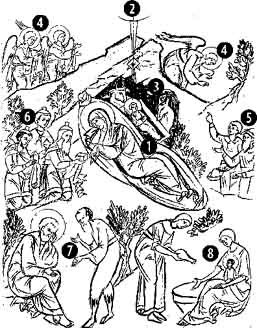 of the other figures, reclining on a mat, and looking not at her new-born Son, but rather with love and compassion towards her spouse, St Joseph the Betrothed (7), seeing his affliction and bewilderment over this most strange and divine birth;. He is shown in the left bottom corner, conversing with Satan, disguised as an old shepherd. The posture of St Joseph is one of doubt and inner trouble, for he wondered if it might be possible that the conception and birth were not by some secret human union; how blessed he was to serve the Mother of God and her divine Son, in spite of these thoughts and temptations, and to protect her from the evil gossip of the people who could not yet possibly understand so great a mystery. Our Lord is shown in swaddling clothes and lying in a manger, "for there was no room for them in the inn." (cf. Luke 2) The back-drop for the manger is a dark cave (3), which immediately reminds us of the cave in which our Lord was buried 33 years later, wrapped in a shroud. In the cave are an ox and ass, details not mentioned by the Gospels, but which are an invariable feature of every icon of the Nativity; the scene is included to show the fulfillment of the words of the prophet Isaiah, "the ox knows his Owner, and the ass his Master's crib, but Israel does not know Me, and the people has not regarded Me" (Isaiah 1:3). (2) Above this central composition, in the very center of the icon is the wondrous star coming from heaven, which led the magi (6) to the place where our Savior lay; It reminds us of the heavenly orb we see on icons of the Theophany, or Pentecost, wherever divine intervention is indicated.
of the other figures, reclining on a mat, and looking not at her new-born Son, but rather with love and compassion towards her spouse, St Joseph the Betrothed (7), seeing his affliction and bewilderment over this most strange and divine birth;. He is shown in the left bottom corner, conversing with Satan, disguised as an old shepherd. The posture of St Joseph is one of doubt and inner trouble, for he wondered if it might be possible that the conception and birth were not by some secret human union; how blessed he was to serve the Mother of God and her divine Son, in spite of these thoughts and temptations, and to protect her from the evil gossip of the people who could not yet possibly understand so great a mystery. Our Lord is shown in swaddling clothes and lying in a manger, "for there was no room for them in the inn." (cf. Luke 2) The back-drop for the manger is a dark cave (3), which immediately reminds us of the cave in which our Lord was buried 33 years later, wrapped in a shroud. In the cave are an ox and ass, details not mentioned by the Gospels, but which are an invariable feature of every icon of the Nativity; the scene is included to show the fulfillment of the words of the prophet Isaiah, "the ox knows his Owner, and the ass his Master's crib, but Israel does not know Me, and the people has not regarded Me" (Isaiah 1:3). (2) Above this central composition, in the very center of the icon is the wondrous star coming from heaven, which led the magi (6) to the place where our Savior lay; It reminds us of the heavenly orb we see on icons of the Theophany, or Pentecost, wherever divine intervention is indicated.
The holy angels (4) are seen both glorifying God and bringing the good tidings of the Lord's birth to the shepherds (5). The fact that Jewish shepherds and heathen magi were among the first to worship our Lord shows us the universality of this great event, meant for the salvation of all mankind.
The final detail of this icon, the scene of the washing of the Lord (8) is an element that has caused some controversy over the ages. In some churches of the holy monasteries of Mount Athos, the scene in the frescoes has been deliberately obliterated and replaced with bushes or shepherds; there was a prevailing opinion that this scene was degrading to Christ, who had no need of washing, being born in a miraculous manner from a pure virgin. But we retain this image on our icons, being part of the holy tradition passed on to us; truly it does not degrade the Lord, but magnifies Him, as is evident in the prayer that is appointed to be read at the time of Baptism for the midwife of a child: (From the Old-rite Potrebnik, 2nd Prayer for the midwife) "O Master, Lord our God...Who didst lie in a manger and didst bless the midwife Salome* who came to believe in an honorable virginity..." [*according to Tradition, Salome was a daughter of St Joseph by his previous marriage] Who, more effectively than a midwife, could testify to the divine and virginal birth? Therefore we do well to understand the importance of this blessed scene.
Finally, as we look at the icon as one united composition, we can only be filled with joy, not only because of the bright colors and the festive activity depicted thereon, but for the joyous news of our salvation so clearly proclaimed by it. In it, all creation is rejoicing at the birth of our Lord: the heavens (a star and angels); the earth (the mountains, plants and animals}; and especially mankind, represented most perfectly in the figure of the new Eve, the most pure Mother of God.
Christ is Born! Glorify Him!

